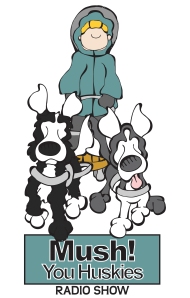Dog Sledding Legend Jean Bryar on Mushing Radio
 On the popular Mush! You Huskies Radio Show we are continuing our summer series on the dog sledding legends and those people that made this sport what it is today. This week we will profile one of the greatest women mushers during the 1960’s and 70’s which so many great mushers followed her lead such as Libby Riddles, Susan Butcher and Dee Dee Jonrowe just to name a few.
On the popular Mush! You Huskies Radio Show we are continuing our summer series on the dog sledding legends and those people that made this sport what it is today. This week we will profile one of the greatest women mushers during the 1960’s and 70’s which so many great mushers followed her lead such as Libby Riddles, Susan Butcher and Dee Dee Jonrowe just to name a few.
Jean Bryar became the foremost woman sled dog driver in the world during the sixties and seventies. Although her husband, Keith, is remembered as the third factor in the Lombard-Belford-Bryar hegemony, Jean was no backseat member of the Bryar team. She worked her way through the New England racing circuit, usually finishing near the top against some of the toughest competition New England has ever had. Having developed one of the best Siberian Husky racing teams in the Northeast, the Bryar’s made the big jump to Alaska with the other New England competitors in the early sixties. They, too, were entranced by the abilities of the Alaskan dogs, and in 1962 they bought a superb example of this racing husky, a leader named Brandy. They paid $1001.00 for him.
During the next four seasons Keith and Jean both drove Brandy at the head of the team that won several of the most important sled dog races in North America. In 1963 they captured the Eastern International at Quebec, the World Championship at Laconia and the Women’s North American Championship at Fairbanks. In Alaska in 1962, 1963 and 1964, Jean paralleled “Doc” Lombard’s wins in the men’s North American with wins of her own in the women’s.
Following Keith Bryar’s successful bid for the Men’s North American Championship in 1965 and his subsequent retirement from racing, Jean Bryar maintained the Norvik Kennels in Center Harbor, New Hampshire and expanded her racing schedule. Coordinating her training and racing talents with those of another champion driver and dog musher, Dick Moulton, Jean went on to secure her own reputation in the sporting world, selecting only the most challenging professional races for their teams. Bryar and Moulton left well-defined tracks wherever they competed.
Bryar had the determination and flexibility of an all-time great sled dog driver. In her first try at the North American, for example, Bryar’s lead dog was of a breed never before known to qualify for such a position, a small longhaired Border Collie. She tended to pamper her dogs a little more than some of her colleague’s thought was necessary, but her achievement as a racer and trainer justified her techniques. Energetic and personable, Bryar was completely dedicated to her dogs. During the off-season she managed her kennel and worked as a real estate agent. When the cool mornings of fall arrived it was back to the business of training puppies and stretching the veteran’s muscles for a new racing season, leaving her work as a realtor to the warmer weather.
__________________
Dr. Robert Forto is the Dog Sledding Examiner, a musher training for his first Iditarod under the Team Ineka banner and the host of the popular, Mush You Huskies Radio Show

